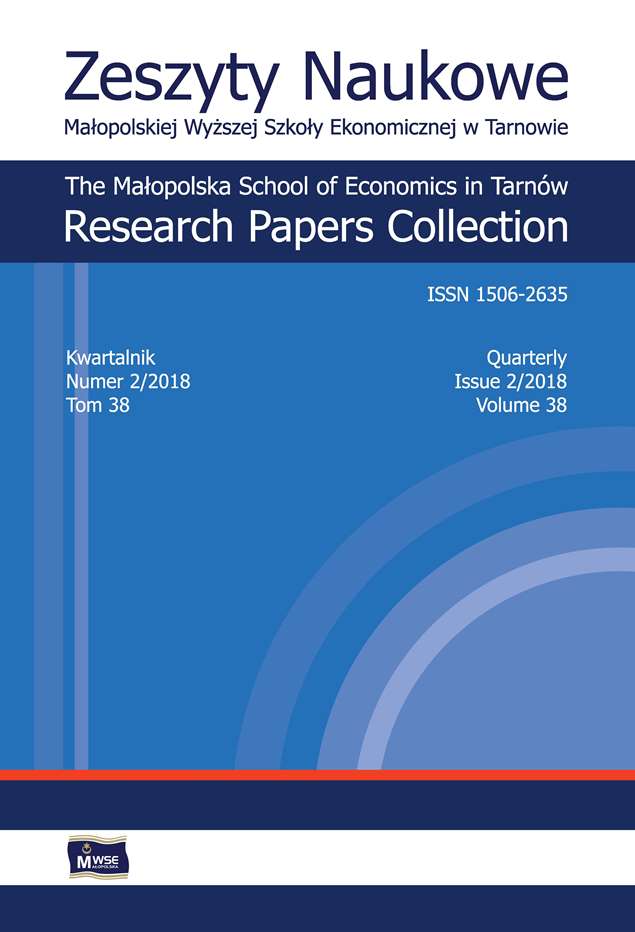Abstract
The aim of the article is to present the concept of the analysis of the work time system in the enterprise, as well as the presentation of empirical research results. Work time analysis still remains a poorly recognized issue of economic analysis. The basic research problem is the identification of the organizational gap, which can be described as the difference between the working methods used in the company and the employed working time system, as well as indication of the possible ways of the gap elimination. A thesis, assuming the correspondence between the working time system and the working method, was adopted. The concept of working method mentioned in the article includes: elements of the production system, elements of the work system and working conditions. These systems (subsystems of the working method) should take into account the principle of economy of operation. These systems (subsystems of the working method) should take into consideration the principle of the economy of operation. The course of analytical procedure (research methodology, suggested in the article, includes the following stages: identification of organizational units and substructures of the enterprise as well as the applied method of work, analysis and evaluation of the working time system, determination of ways to improve the working time system. In support of the thesis, the empirical part of the article presents the results of research in the form of a case study (case study protocols). It describes and assesses work time systems together with identified methods of work in the coking industry enterprise as well as the creative industry companies (freelancing) employing external experts. The economic analysis results were supplemented with opinions of the management staff and employees, being used to improve the existing working time system. The research methods were used to implement the indicated purpose: the analysis of the prior research results, economic analysis, the elements of ergonomic analysis, interview and questionnaire.
References
ArcelorMittal. (2018). Zdzieszowicka koksownia ArcelorMittal Poland wdraża inicjatywy środowiskowe za 90 mln zł [online, dostęp: 2018-06-20]. Informacja prasowa. Dostępny w Internecie: https://poland.arcelormittal.com/uploads/tx_bwsinfopras/Zdzieszowicka_koksownia_inwestuje_90_mln_zl_w_ochrone_srodowiska.pdf.
View in Google Scholar
ArcelorMittal Poland S.A. Koksownia Zdzieszowice. (2013). Materiały wewnętrzne. Sygn. C/NZ/0513/5/2013.
View in Google Scholar
Chobot, A. (2003). Czas pracy w znowelizowanym kodeksie pracy. Poznań: Wydawnictwo Poznańskie. ISBN 8371772564.
View in Google Scholar
Driczinski, S. (2000). Skrócony czas pracy – niektóre problemy i propozycje rozwiązań. Praca i Zabezpieczenie Społeczne, 3, 9–18.
View in Google Scholar
Janus, E. (2016). Dylematy zawodowe freelancera – od bezpieczeństwa zatrudnienia do niezależności. Humanizacja Pracy, 1, 77–86.
View in Google Scholar
Johns, T. (2003). Doskonałe zarządzanie czasem. Poznań: Rebis. ISBN 8371208758.
View in Google Scholar
Kalinowska, I., Kujszczyk, B., Mańturz, M., Świercz, B. (2011). Elastyczne formy zatrudnienia. Informator. Warszawa: Wojewódzki Urząd Pracy. ISBN 9788362188109.
View in Google Scholar
Kozioł, L. (2000). Zarządzanie czasem pracy. Kraków: Antykwa. ISBN 8387493015.
View in Google Scholar
Kozioł, L. (2002). Motywacja w pracy. Determinanty ekonomiczno-organizacyjne. Warszawa–Kraków: Wydawnictwo Naukowe PWN. ISBN 830113786X.
View in Google Scholar
Kozioł, L., Pyrek, R. (2009). Model systemu zarządzania czasem pracy w przedsiębiorstwie. Zeszyty Naukowe Małopolskiej Wyższej Szkoły Ekonomicznej w Tarnowie, 13(2/2), 339–350.
View in Google Scholar
Lis, S., Santarek, K., Strzelczak, S. (1994). Organizacja systemów produkcyjnych. Warszawa: Wydawnictwo Naukowe PWN. ISBN 8301112298.
View in Google Scholar
Makowiec, M. (2016). Metodyka humanizowania telepracy. Kraków: Wydawnictwo Uniwersytetu Ekonomicznego. ISBN 9788372527332.
View in Google Scholar
Muszyński, Z. (2007). Ergonomiczne uwarunkowania systemu zarządzania czasem pracy w przedsiębiorstwie. Zeszyty Naukowe – Polskie Towarzystwo Ekonomiczne, 5, 155–167.
View in Google Scholar
Olejniczak, A. (2013). Efektywne zarządzanie czasem – wybrane zagadnienia. MINIB: Marketing Instytucji Naukowych i Badawczych, 1(7), 3–21.
View in Google Scholar
Olszewski, J. (2013). System pracy w warunkach globalnego społeczeństwa informacyjnego. Poznań: Wydawnictwo Uniwersytetu Ekonomicznego. ISBN 9788374177757.
View in Google Scholar
Penc, J. (1987). Społeczne zmiany w systemie pracy. Kultura i Społeczeństwo, 2, 135–153.
View in Google Scholar
Roguszczak, M. (2010). Zarządzanie czasem pracy menedżera. Warszawa: Dom Wydawniczy ELIPSA. ISBN 9788371518898
View in Google Scholar
Scholz, Ch. (1994). Personalmanagement. München: Verlag Vahlen. ISBN 3800619040.
View in Google Scholar
Seiwert, L.J. (1998). Zarządzanie czasem. Bądź panem własnego czasu. Warszawa: Placet. ISBN 8385428305.
View in Google Scholar
Stroińska, E. (2012). Elastyczne formy zatrudnienia. Telepraca, zarządzanie pracą zdalną. Warszawa: Poltext. ISBN 9788375613650.
View in Google Scholar
Suri, R., Krishnamurthy, A. (2003). How to Plan and Implement POLCA. A Material Control System for High-Variety or Custom-Engineered Products. Technical Report. Center for Quick Response Manufacturing. Wisconsin: University of Wisconsin–Madison.
View in Google Scholar
Śleziak, M. (2011). Dlaczego warto korzystać z metody Time Boxing [online, dostęp: 2018-03-15]. Mini-CRM. Bielsko-Biała: Ageno Maksymilian Ślęziak i Krzysztof Kowalik S.C. Dostępny w Internecie: https://minicrm.pl/blog/dlaczego-warto-korzystac-z-metody-time-boxing/.
View in Google Scholar
Walczyna, A., Łucjan, I. (2012). Postęp techniczny a humanizacja pracy. Postępy Nauki i Techniki, 12, 190–198.
View in Google Scholar
© Copyright by Małopolska School of Economics in Tarnów. The articles are available under the Creative Commons Attribution NonCommercial-NoDerivatives 4.0 International License


